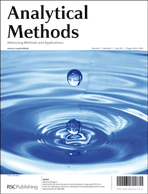In this study, a rapid, convenient and in situ applicable Cu2+ sensor was constructed based on a luminescent layer immobilizing Ru(bpy)3Cl2 with a maximum wavelength of 600 nm, which was taken as the reference background light. The luminescence intensity of the layer was kept constant and isolated from the oxygen change in the solution due to the hybrid polyacrylonitrile–dimethylsulfoxide used in the immobilization of the Ru(bpy)3Cl2. The CdTe quantum dot (QD) luminescence, with a maximum wavelength of 520 nm, was quenched to different degrees depending on the Cu2+ concentration in the solution. Using a commercial camera, different colors could be captured in different Cu2+ concentrations. This color change was caused by the composite light with stable luminescence from the Ru(bpy)3Cl2 layer and the changeable fluorescence of the CdTe QDs. Sensor characteristics, including the co-existing ions, oxygen content, temperature effect, and sensor stability, were investigated.
You have access to this article
 Please wait while we load your content...
Something went wrong. Try again?
Please wait while we load your content...
Something went wrong. Try again?


 Please wait while we load your content...
Please wait while we load your content...